Tackling the task of cleaning a non-stick pan can often feel like navigating a culinary minefield – one wrong move, and you could end up with a scratched surface or a lingering residue that refuses to budge.
But fear not, for within the seemingly mundane realm of kitchen maintenance lies an artful dance of precision and care. Imagine your non-stick pan as a cherished possession, deserving of tender love and attention.
With the right knowledge and techniques, you can transform the seemingly mundane act of cleaning into a ritual of restoration, ensuring that your culinary adventures unfold on a canvas as pristine and slick as the day you first acquired it.
So, let us embark on a journey to unveil the secrets of maintaining the gleaming allure of your non-stick pan, ensuring that every meal you create emerges effortlessly and flawlessly from its sleek surface.
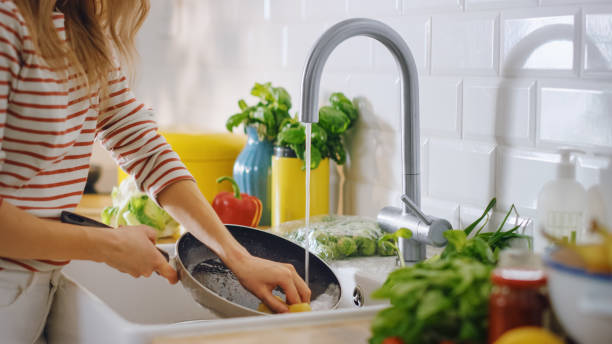
What Is Non stick Cookware?
Non stick cookware refers to a range of kitchen utensils typically coated with a special substance that prevents food from sticking during cooking.
This coating, often made from materials like polytetrafluoroethylene (PTFE), commonly known as Teflon, or ceramic, creates a smooth, slippery surface that minimizes the need for excessive oil or butter while cooking.
This property not only promotes healthier cooking but also makes cleaning up a breeze. Nonstick cookware comes in various forms, including frying pans, saucepans, and baking sheets, catering to a wide array of culinary needs.
Its popularity stems from the convenience it offers in preparing delicate foods like eggs, pancakes, and fish, which are prone to sticking on traditional cookware surfaces.
However, it’s essential to handle non stick cookware with care, avoiding abrasive cleaning tools or high heat settings that can damage the coating and compromise its non stick properties.
How To Clean A Non Stick Pan
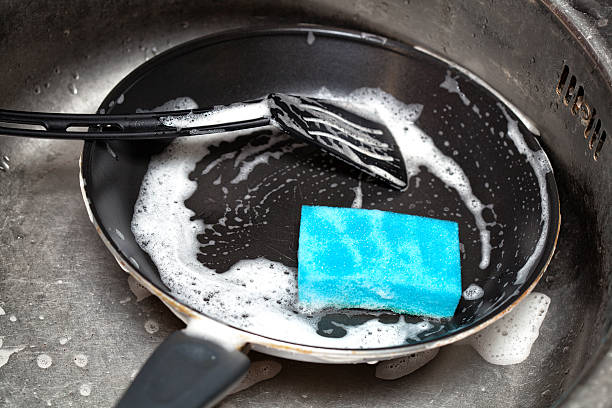
Cleaning a non stick pan properly ensures its longevity and maintains its nonstick properties. Here are five steps to effectively clean a nonstick pan:
Allow The Pan To Cool Down
Allowing the pan to cool down is the first step in effectively cleaning a non stick pan. After cooking, remove the pan from the heat source and let it cool naturally on a heat-resistant surface.
This cooling period prevents potential damage to the nonstick coating that could occur from sudden temperature changes, such as placing a hot pan under cold water. Cooling down the pan makes it safer to handle during the cleaning process, reducing the risk of burns or accidents.
Once the pan has cooled to a safe temperature, proceed with the remaining steps for cleaning to maintain its nonstick properties and extend its lifespan.
Brush Or Scrub The Pan
Once the non stick pan has cooled down, the next step in the cleaning process is to gently brush or scrub the surface to remove any food residue. Using a soft-bristled brush or a non-abrasive sponge, lightly scrub the interior and exterior of the pan.
Be sure to pay extra attention to areas where food may have stuck, such as the bottom and sides. Avoid using abrasive materials like steel wool or harsh scouring pads, as they can scratch and damage the nonstick coating.
Instead, opt for gentle cleaning tools to preserve the integrity of the pan’s surface. If necessary, you can also use a small amount of mild dish soap to help lift stubborn stains or residues. After scrubbing, rinse the pan thoroughly with warm water to remove any soap or remaining debris.
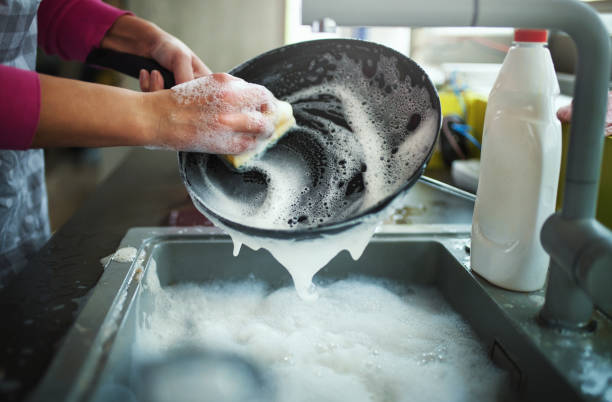
Thoroughly Rinse The Pan
After brushing or scrubbing the non stick pan to remove food residue, the next step is to thoroughly rinse it under warm water. Rinse both the interior and exterior of the pan to ensure all soap and debris are removed. Use your hands or a soft sponge to gently rub the surface while rinsing to help dislodge any remaining particles.
Make sure the water runs clear, indicating that all soap and food residue have been effectively washed away. Thorough rinsing is crucial to prevent any soap residue from affecting the pan’s nonstick properties or leaving behind unwanted flavors in your next cooking endeavor.
Once the pan is thoroughly rinsed, shake off any excess water and inspect it to ensure it’s clean and free of any remaining debris. This step sets the stage for the final drying process, ensuring the pan is ready for storage or immediate use.
Treat The Burnt Areas
If you encounter burnt areas on your non stick pan during the cleaning process, it’s essential to address them promptly to prevent damage to the non stick coating.
One effective method is to create a simple cleaning paste using baking soda and water. Mix a small amount of baking soda with water to form a paste-like consistency.
Apply the baking soda paste to the burnt areas of the pan, covering them completely. Allow the paste to sit on the burnt spots for about 15-20 minutes.
The baking soda’s abrasive nature combined with its mild alkalinity helps to lift and loosen the burnt-on food particles without scratching the nonstick surface.
After allowing the paste to sit, gently scrub the burnt areas with a soft-bristled brush or sponge. Be cautious not to scrub too vigorously, as this could damage the non stick coating. Rinse the pan thoroughly with warm water to remove the baking soda residue and any loosened debris.
Inspect the pan to ensure all burnt spots have been effectively treated and removed. If necessary, repeat the baking soda treatment until the burnt areas are completely eliminated.
Once cleaned, proceed with the final step of drying the pan thoroughly before storing or using it again. Treating burnt areas promptly helps maintain the integrity of your nonstick pan and ensures its longevity for future use.
Condition The Pan
Conditioning the non stick pan is an optional but beneficial step to help maintain its non stick properties and prolong its lifespan. After cleaning and drying the pan thoroughly, you can apply a small amount of cooking oil or melted shortening to the interior surface.
Using a paper towel or a clean cloth, spread the oil evenly across the entire cooking surface, including the bottom and sides of the pan. Make sure to use a minimal amount of oil to avoid creating a greasy residue.
Once the pan is lightly coated with oil, heat it over low to medium heat for a few minutes. Heating the pan helps the oil to penetrate the nonstick coating, creating a protective layer that enhances its nonstick properties.
After heating, allow the pan to cool completely before storing it. Conditioning the pan in this manner helps to replenish any oils that may have been removed during cleaning and cooking, ensuring that the non stick surface remains effective over time.
It’s important to note that not all non stick pans require conditioning, especially those with modern coatings designed to be durable and long-lasting.
However, if you notice a decline in the pan’s non stick performance or if the manufacturer recommends conditioning, this step can be beneficial for maintaining the pan’s quality and performance.
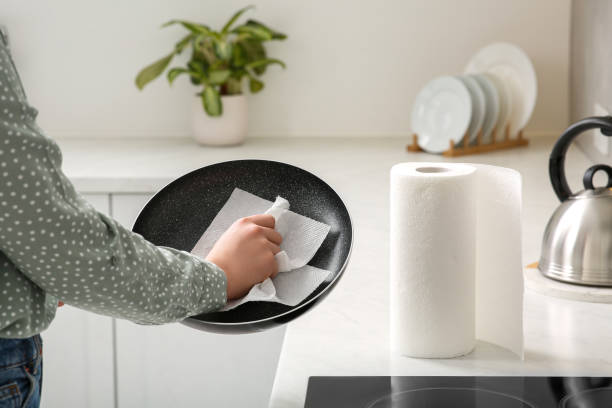
6 Tips On How To Take Care Of Your Nonstick Pan
Taking care of your non stick pan is essential to maintain its performance and extend its lifespan. Here are six tips to help you keep your non stick pans in top condition:
Avoid Using Cooking Spray
One crucial tip for maintaining your non stick pan is to avoid using cooking spray. While it may seem convenient, cooking spray can actually build up on the surface of the pan over time, creating a sticky residue that diminishes the pan’s nonstick properties.
The propellants and additives in cooking sprays can leave behind a film that is difficult to remove, further reducing the effectiveness of the non stick coating.
Instead of cooking spray, use a small amount of oil or butter to lightly grease the pan before cooking. This will provide the necessary lubrication without compromising the non stick surface.
By avoiding cooking spray and opting for alternative greasing methods, you can help preserve the integrity of your non stick pan and ensure it maintains its nonstick properties for longer-lasting performance.
Avoid High Heat Temperature
It’s crucial to avoid subjecting non stick pans to high heat temperatures. Non stick coatings are not designed to withstand extreme heat, as it can degrade the coating and compromise its non stick properties.
Using low to medium heat settings is recommended to prevent overheating, which can cause the coating to release harmful fumes and lose its effectiveness over time.
By regulating the temperature and avoiding high heat, you can preserve the integrity of your non stick pan and ensure consistent cooking results without risking damage to the coating.
Avoid Using Dishwasher
To maintain the quality and longevity of your non stick pans, it’s best to avoid using dishwashers for cleaning.
The harsh detergents and high temperatures in dishwashers can damage the nonstick coating, leading to peeling, flaking, or diminished non stick performance over time. Instead, opt for hand washing with a mild dish soap and warm water.
Use a soft sponge or cloth to gently clean the pan’s surface, ensuring thorough yet gentle removal of food residues. By hand washing your nonstick pans, you’ll protect their integrity and preserve their nonstick properties for prolonged enjoyment in the kitchen.
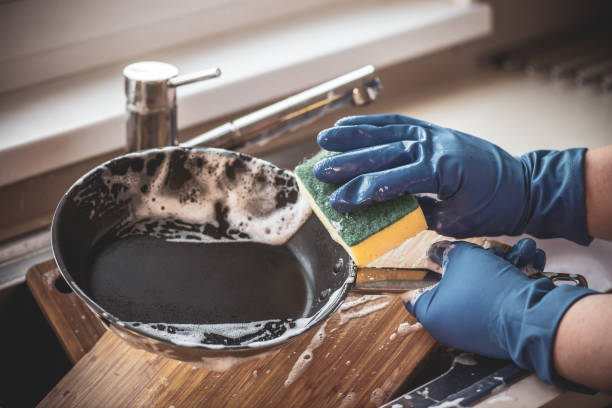
Avoid Using Steel Wool
Steer clear of using steel wool or other abrasive cleaning tools when caring for your non stick pans. While steel wool may effectively remove stubborn stains or residues, it can scratch or damage the delicate non stick coating, compromising its effectiveness and longevity.
Opt for non-abrasive cleaning methods instead, such as using a soft sponge or cloth with mild dish soap and warm water. These gentler approaches will help preserve the integrity of the non stick surface, ensuring your pans maintain their nonstick properties for extended use in the kitchen.
Use A Paper Towel Or Dishcloth To Dry The Nonstick Pan Surface
After hand-washing your non stick pan, it’s important to dry the surface thoroughly to prevent water spots and potential rust formation. However, avoid using abrasive materials like kitchen towels or dishcloths, as they can inadvertently scratch or damage the non stick coating.
Instead, opt for a soft and non-abrasive option such as a paper towel or a dedicated dishcloth reserved for drying non stick pans. Gently pat the surface dry with the chosen material, ensuring all moisture is absorbed.
This gentle approach will help maintain the integrity of the non stick surface, prolonging its lifespan and preserving its non stick properties for continued use in your kitchen endeavors.
Use Dishcloth Or Paper Towel In Between Each Pan
When stacking non stick pans for storage, it’s advisable to place a dishcloth or a sheet of paper towel between each pan to prevent scratches and damage to the nonstick coating.
This simple precaution helps to cushion the pans and minimize friction between them, preserving their smooth surfaces and nonstick properties.
Using a clean dishcloth or paper towel creates a barrier that prevents any residual moisture or oils from transferring between the pans, which could potentially affect their performance over time.
By incorporating this practice into your storage routine, you can ensure that your nonstick pans remain in optimal condition for long-lasting use in the kitchen.
Recommended Cooking Utensils To Use With A Nonstick Pan
When using nonstick pans, it’s important to choose cooking utensils that are gentle on the nonstick coating to avoid scratching or damaging it. Here are some recommended cooking utensils to use with a non stick pan:
Bamboo And Wood
Bamboo and wood utensils are excellent choices for use with nonstick pans. These materials are naturally gentle on the nonstick coating, reducing the risk of scratches or damage.
Bamboo and wood utensils also have smooth surfaces that won’t leave marks on the pan’s surface, ensuring its longevity. They are lightweight, comfortable to handle, and heat-resistant, making them versatile tools for flipping, stirring, and serving various dishes.
With proper care, bamboo and wood utensils can be reliable companions in your kitchen, enhancing your cooking experience while preserving the integrity of your non stick pans.
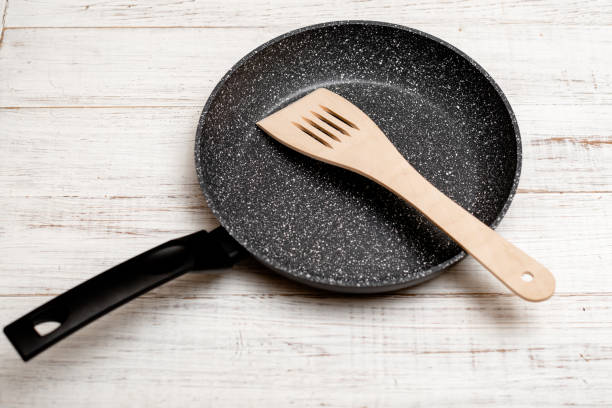
Nylon or Plastic Utensils
Nylon or plastic utensils are another excellent choice for use with non stick pans. These utensils are lightweight, durable, and gentle on the non stick coating, minimizing the risk of scratches or damage.
Nylon and plastic utensils typically have smooth edges, ensuring they won’t leave marks on the pan’s surface. They are heat-resistant and dishwasher-safe, making them convenient and easy to clean.
Whether you’re flipping pancakes or stirring sauces, nylon or plastic utensils provide reliable performance without compromising the integrity of your non stick pans.
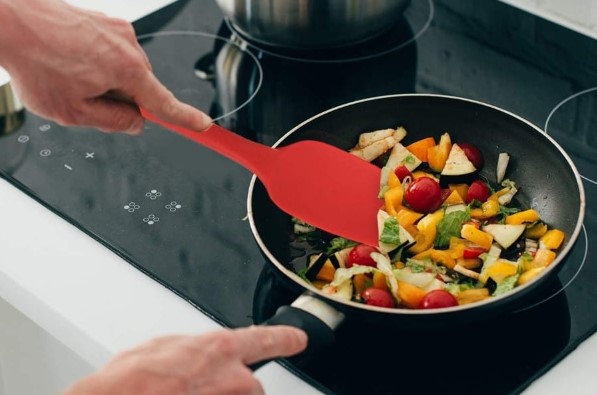
Rubber or Silicone Tongs
Rubber or silicone-tipped tongs are a great option for handling food in non stick pans. The rubber or silicone tips provide a secure grip on food without scratching or damaging the nonstick coating.
These tongs are designed to be gentle on the pan’s surface, ensuring its longevity. Rubber or silicone tongs are heat-resistant, making them suitable for use in high-temperature cooking.
Whether you’re flipping delicate items like fish fillets or serving pasta, rubber or silicone tongs offer precision and control while protecting your non stick pans from harm.
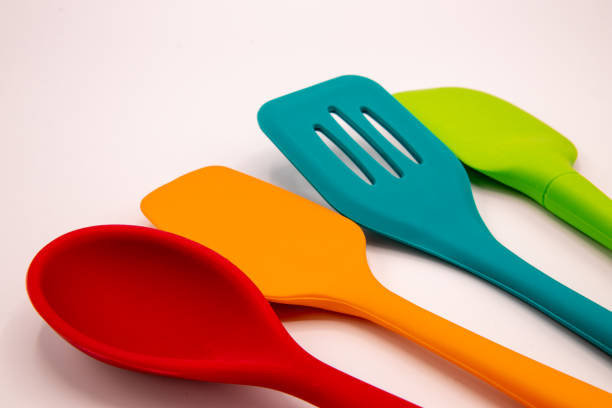
Silicone Basting Brush
A silicone basting brush is an essential tool for applying oils, sauces, or marinades to food in non stick pans. Silicone brushes are soft, flexible, and heat-resistant, making them ideal for use with non stick cookware.
They glide smoothly over the pan’s surface without scratching or damaging the coating, ensuring its longevity. Silicone brushes are also easy to clean and dishwasher-safe, offering convenience and hassle-free maintenance.
Whether you’re glazing vegetables, basting meats, or adding flavor to your dishes, a silicone basting brush provides precise application while preserving the integrity of your non stick pans.
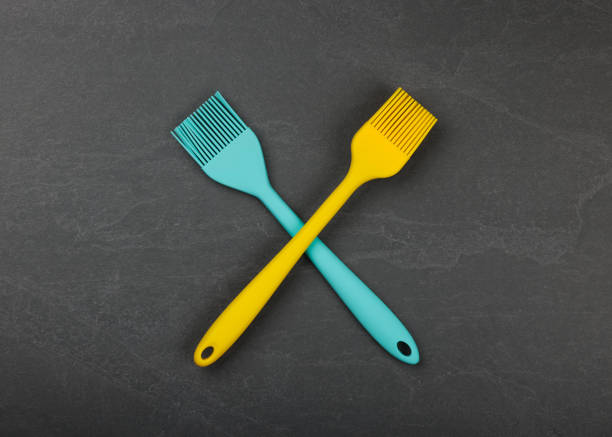
Silicone Spatula
A silicone spatula is an indispensable utensil for cooking with non stick pans. Its soft, flexible, and heat-resistant silicone head makes it perfect for flipping, stirring, and scraping food in non stick cookware without scratching or damaging the coating.
Silicone spatulas come in various shapes and sizes, allowing for versatile use in different cooking tasks. Whether you’re folding delicate omelets, flipping pancakes, or sautéing vegetables, a silicone spatula offers excellent precision and control.
Silicone spatulas are easy to clean, dishwasher-safe, and highly durable, making them a reliable choice for everyday cooking needs. With a silicone spatula, you can confidently tackle any recipe while preserving the integrity of your non stick pans.
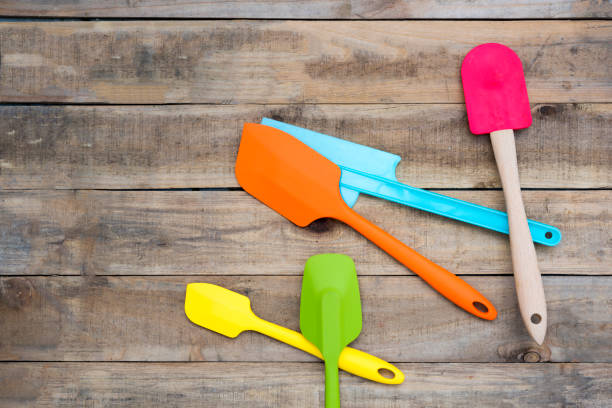
Frequently Asked Questions (FAQs) – How To Clean A Non Stick Pan
Q: What are the benefits of regularly cleaning my non-stick pan?
A: Regular cleaning of your non-stick pan ensures its longevity and maintains its efficiency in cooking delicious meals. It prevents the buildup of residues and ensures that your food cooks evenly every time.
Q: How often should I clean my non-stick pan?
A: It’s recommended to clean your non-stick pan after each use to maintain its non-stick properties and keep it in pristine condition. This ensures that you’re always ready to whip up your favorite dishes without any hassle.
Q: What’s the best way to clean a non-stick pan without damaging its surface?
A: The best way to clean a non-stick pan is by using gentle cleaning methods such as warm soapy water and a soft sponge or cloth. Avoid harsh abrasives or metal utensils that could scratch the surface and compromise its non-stick properties.
Q: Can I use dishwashers to clean my non-stick pan?
A: While some non-stick pans may be labeled as dishwasher safe, it’s generally recommended to hand wash them to preserve their non-stick coating for longer. Hand washing allows you to control the cleaning process and ensures gentler treatment of the pan.
Q: How can I remove stubborn stains or residues from my non-stick pan?
A: Stubborn stains or residues on your non-stick pan can be easily removed by soaking the pan in warm, soapy water for a few minutes and then gently scrubbing with a soft sponge or brush. For particularly tough stains, you can try using a mixture of baking soda and water as a gentle abrasive.
Q: Are there any special care tips for storing my non-stick pan?
A: To prolong the life of your non-stick pan, it’s best to store it in a dry and cool place away from direct heat sources. Avoid stacking other pots and pans on top of it to prevent scratching, and consider using protective pan separators if storing multiple pans together.
Q: How can I ensure that my non-stick pan stays in top condition for years to come?
A: By following proper cleaning and maintenance practices, such as avoiding high heat settings, using gentle utensils, and storing it properly, you can ensure that your non-stick pan remains in excellent condition and continues to provide reliable cooking performance for years to come.
Conclusion
In conclusion, maintaining the quality and longevity of non-stick pans requires consistent and proper cleaning methods.
By incorporating gentle techniques such as using mild detergents, soft sponges, and avoiding abrasive tools, one can effectively remove residue without compromising the non-stick coating.
Implementing preventative measures such as avoiding high heat and storing pans appropriately can further extend their lifespan.
Ultimately, adhering to these cleaning practices ensures that non-stick pans remain a reliable and durable tool in the kitchen, consistently delivering optimal cooking results for years to come.
Other Articles You May Also Like: